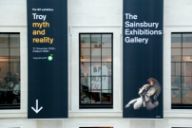The BP exhibition: Troy, myth and reality
On the 21st of November 2019, the British Museum launched its long-awaited exhibition on the ancient city of Troy. In the months leading up to and during the exhibition, the advertisements did not try to conceal the fact that it was sponsored by BP, hence its primary title The BP exhibition. Although the exhibition itself had little to do with the oil giant, BP’s name and logo were irrefutably connected to the exhibition.
The exhibition itself received good reviews as it offered a fresh look on an often exhibited subject. The first half featured archaeological artefacts, which proved the existence of the real Troy but served mostly as a stimulus to retell the ancient tales of Homer and Vergil about the infamous Trojan war. Various vases, statues and artworks depicted the stories of the Greek Achilles, conscious of his own death and struck by wrath in conflict with king of kings Agamemnon. Of Trojan Hector, leaving his wife Andromache for fated battle, only to be slayed and dragged around the Trojan walls. Of Ulysses and Aeneas, both having to cope with the aftermath of war, one in search of his old home, the other in search of a new one. The end of the first half of the exhibition was marked by a giant hollow casket of the Trojan horse, a canonical story amongst the narratives of the Trojan war: in order to lay siege on the city and bring it to fall, the Greeks devised a plan to enter without the Trojans knowing. They presented an enormous wooden horse as a peace offering in disguise, having secretly hidden Greek soldiers on the inside of the structure. According to the Greek plan, but against all discouraging omens, the Trojans unknowingly accepted their gift-wrapped demise and lost the war they had endured for ten years.
Thus the first half of the exhibition featured the oft told stories, but its fresh stance came from the works of art that had contemporised the Trojan stories for so many years, chronologically set up in the second half of the exhibition. From the European Renaissance to Asian arts, from theatre performances to light installations, from realistic narrative adaptations to abstract-expressionist depictions; they all share the need to bring ancient Troy back to life in their own context. Sometimes the artists of these works seem to be inspired by the ancient narratives, but more often the works disclose the political relevance of the Trojan war and its stories.
Evidently, the relevance of the Trojan war had not gone unnoticed by the activists that took a firm stance against BP’s sponsorship for this exhibition. Throughout the three-day protest, in order to confront the oil giant BP or not BP accordingly chose as its main weapons the imagery and narratives of the Trojan war: exactly that which BP purported to sponsor. By means of deconstruction, the group set out to uncover a lot of the ironies and twists in the story of BP’s sponsorship. How did the activists do so? In other words, how and why did they translate the Trojan horse from its ancient context, to this new emancipatory, activist context?

